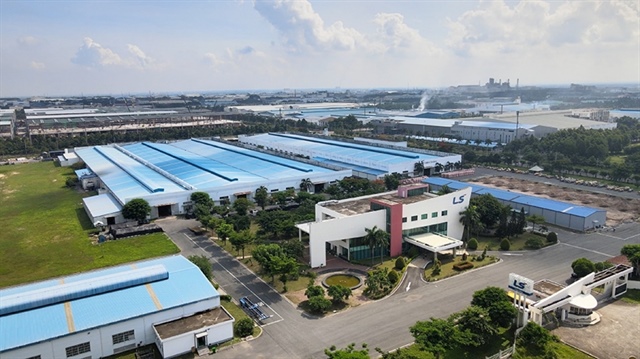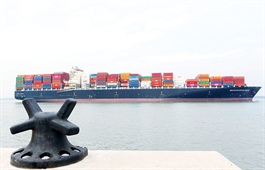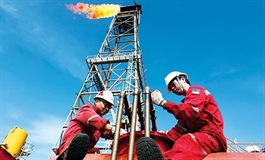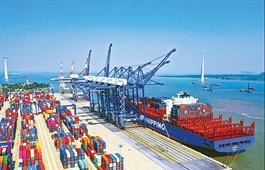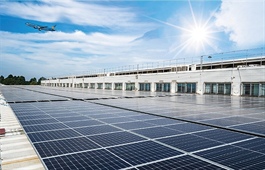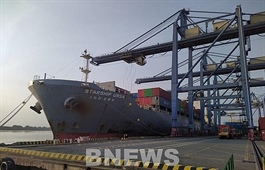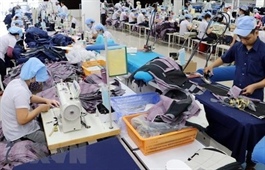Agriculture reaching for the skies
Agriculture reaching for the skies
Vietnam’s agriculture got hit hard by the pandemic as trade and social restrictions hampered the flow of goods and left many sitting on their produce and livestock. Nevertheless, according to Dr. Tran Cong Thang, director of the Institute of Policy and Strategy for Agricultural and Rural Development under the Ministry of Agriculture and Rural Development, the country’s farmers and agricultural businesses have shown resilience, and are now ready to cash in on many international trade deals that Vietnam signed throughout the last few years.

Dr. Tran Cong Thang, director of the Institute of Policy and Strategy for Agricultural and Rural Development under the Ministry of Agriculture and Rural Development
|
Last year imposed many difficulties for the Vietnamese and other economies, as the pandemic and prevention measures to curb the spread of the disease exacerbated pre-existing difficulties, mainly due to reduced economic activities, resulting in loss of income, and reduced household purchasing power, leaving a major impact on the food supply system.
The International Monetary Fund had to reduce its forecast global growth rate for 2020, from -3 per cent at the beginning of the year to -4.4 per cent, down sharply from the 5.5 per cent of 2019 – a clear indicator of an economic recession.
In previous crises, such as the 1997-1998 Asian financial crisis, the agricultural sector played an important support role in many countries through food supply and jobs, and Vietnam was no exception.
However, more than 20 years later, economic growth and the accompanying structural transformation of regional economies have resulted in a decrease of the agriculture’s share in GDP, while rural households had to depend more on non-agricultural income.
Therefore, the supporting role of agriculture from the past has been challenged, especially as the supply chains and the domestic market have been disrupted, with exports also facing many difficulties as several countries still limit logistics activities.
Standing one’s ground
The Vietnamese agricultural sector has adapted well to the challenges of the COVID-19 pandemic and other disasters. Production in all agricultural sectors, such as cultivation, husbandry, fishery, and forestry, has been maintained and developed, ensuring sufficient supply for the needs of the nearly 100 million people living in Vietnam.
Last year, the agricultural sector made great efforts to complete four important targets: The production value of the whole industry increased by 2.75 per cent compared to 2019, of which cultivation increased by 2.7 per cent, forestry by 2.4 per cent, and aquaculture by 3.3 per cent. Meanwhile, the growth whole sector increased by 2.65 per cent.
COVID-19 forced many countries around the world to close their borders, limit imports, and cancel or delay outstanding orders, leaving supply chains interrupted and many markets heavily affected. Nevertheless, Vietnam managed to keep exports largely flowing. According to Trade Map statistics, in the first 10 months of 2020, China’s agro-forestry-fishery exports decreased by 28 per cent, the United Kingdom’s by 13 per cent, Australia’s by 8.8 per cent, the United States’ by 4 per cent, and Thailand’s by 3 per cent on-year. Meanwhile, Vietnam kept its agricultural export turnover in 2020 roughly equivalent to that of 2019.
By the end of 2020, the total export turnover of agro-forestry-fishery reached $41.2 billion, up 2.5 per cent compared to 2019. For the first time, Vietnam’s rice exports surpassed Thailand’s, and that amid one of the most difficult and challenging times.
Part of this success is the promotion of the agricultural processing industry, which managed to strongly attract investment, especially larger groups with high technology. During the past term, 68 processing factories were built throughout all major segments, of which 18 factories came into operation right in 2020.
Despite the pandemic, storms, and floods, the Ministry of Agriculture and Rural Development, as the standing agency for natural disaster prevention, has effectively orchestrated the response to these disasters and overcoming their consequences, thus minimising the damage to people and assets.
The ministry’s direction and management have helped to respond to these natural disasters and change the production structure at many facilities to become more flexible. For instance, although the last drought was more severe than many before, the damage accounted for only about 9 per cent of the drought in 2016.
Creating momentum
Despite the successes, most households in agricultural and rural areas were heavily affected by the pandemic, especially during times of social restrictions.
According to a survey by the Institute of Policy and Strategy for Agricultural and Rural Development, right after the first COVID-19 wave, about 35 per cent of farming households said they were affected by the pandemic. However, this rate is much lower than that of non-agricultural households, with 67 per cent reporting to have been affected, especially those with salaried workers.
Most agricultural businesses are still operating, but some that depend on annual crops like rice, vegetables, and fruits have seen slight interruptions in their operations. According to a survey by the General Statistics Office, about a third of all agri-businesses have experienced some sorts of difficulty related to input markets due to reduced access to imported goods and narrowed domestic production.
About two out of five agri-businesses also reported disruption in output markets as export orders and domestic demand decreased, while some costs (like the ones for storage and transportation) even increased. However, the number of agri-businesses with these issues overall remained lower than the national average.
In 2021, the world economy is expected to continue to face many challenges and will also influence Vietnam’s agriculture. As the pandemic remains rampant in many countries, supply chains and the general global economic orders are prone to disruptions.
Besides the COVID-19 pandemic, diseases like African swine fever and bird flu also need a long time to be handled correctly and continue leaving a mark on export and domestic consumption. Climate change is becoming more and more visible and, despite national and global efforts, remains unpredictable, with natural disasters like droughts and saltwater intrusion forecast to impact production and livelihoods. These threats will require the whole industry to find appropriate responses and long-term strategies to minimise damage.
The economy continues to benefit from its success in controlling the pandemic and improving the business and investment environment, with the latter expected to be the main driver behind economic growth in 2021.
In addition, the accelerated economic restructuring will enable the agricultural sector to take advantage of the advances in innovation and applied technologies that will improve efficiency in processing and logistics, as well as the momentum of the domestic market, expanding international trade under the recently enacted bi- and multilateral free trade agreements.
|
Short-term focus in agricultural development - Efforts will be made to strictly control diseases and pests and stabilise production to ensure national food reserves; - The value chains will be further extended by creating more links between producers and distributors, as well as diversifying distribution channels and product variety to meet consumer demand and reduce risks; - Exports will be further promoted, particularly in unison with the opportunities from the multitude of free trade agreements that Vietnam signed with its partners; - Consumption shall be stimulated to develop the domestic market both in rural and urban areas; - Fair trade shall be supported, particularly at points of sales and ecommerce platforms; and - Logistics shall be supported and developed to avoid export route blockades and ensure a consistent flow of goods, for example, by applying a green corridor policy for trade. Medium- and long-term focus in agricultural development - Vietnam’s agriculture shall be developed in the direction of sustainable, green, and high-quality production with the help of digital technologies and innovation; - Smart agricultural value chains shall be established to improve efficiency, reduce direct labour, and switch from a traditional distribution system to online and/or online-supported models by applying modern technologies; - Priority shall be given to attracting public and private investment to further develop processing industries, preservation, and packaging, in addition to developing a logistics system that supports the supply chain and links local goods with the global value chain to meet the new needs of global consumers; - Digitalisation shall be implemented in state management systems and public services to support the agricultural sector with issues such as product traceability, food safety, quality management, and access to markets and finance; - Focus should also lie on vocational training and the development of new skills for rural residents, to make them ready to respond to changes and new market demands; - A long-term strategy needs to be established to improve the sector’s preparedness and response options for natural disasters, with approaches tailored to each group of agribusinesses; and - Natural resource management and biodiversity conservation goals shall be integrated into the socioeconomic development planning and management of biospheres in Vietnam. Source: Institute of Policy and Strategy for Agricultural and Rural Development |





